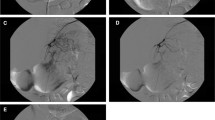Abstract
Purpose
This study assessed the safety and effectiveness of a technical modification that involves adding short gastric artery (SGA) embolization to left gastric artery (LGA) embolization.
Material and Methods
This retrospective single-center study analyzed twenty obese patients (median age of 53.5 (30–73)) who were not eligible for bariatric surgery and underwent bariatric embolization with 300–500-µm microspheres in addition to a lifestyle counseling program between March 2021 and July 2022. Eight patients had LGA + SGA embolization, and twelve had LGA embolization alone. The primary outcome measure was total body weight loss (TBWL) at 6 months in the SGA + LGA and the LGA-only cohorts. Safety was assessed, defined as the 30-day adverse events rate according to the SIR classification.
Results
The mean 6-month post-embolization TBWL in the SGA + LGA cohort was 7.3 kg (95%CI 2.1–12.4; p = .01) and 4.1 kg (95%CI 0.4–8.6; p = 0.034) in the LGA-only cohort (mean difference − 3.1 kg ± 2.8; 95%CI (− 9.1–2.8); p = .28). The mean 6-month post-embolization TBWL in the entire cohort was 5.3 kg (p < .01). The rate of complications was similar between the two groups.
Conclusion
Combined SGA and LGA embolization is safe and effective to treat obesity. Larger studies are needed to determine whether SGA + LGA embolization results in more significant weight loss than LGA embolization alone.
Graphical Abstract



Similar content being viewed by others
Data Availability
The datasets generated or analyzed during the study are available from the corresponding author on reasonable request.
References
Reddy VY, Neužil P, Musikantow D, et al. Transcatheter bariatric embolotherapy for weight reduction in obesity. J Am Coll Cardiol. 2020;76(20):2305–17.
Weiss CR, Abiola GO, Fischman AM, et al. Bariatric embolization of arteries for the treatment of obesity (BEAT Obesity) trial: results at 1 year. Radiology. 2019;291(3):792–800.
Loukas M, Wartmann CT, Louis RG Jr, et al. The clinical anatomy of the posterior gastric artery revisited. Surg Radiol Anat. 2007;29(5):361–6.
Filippiadis DK, Binkert C, Pellerin O, Hoffmann RT, Krajina A, Pereira PL. Cirse quality assurance document and standards for classification of complications: the cirse classification system. Cardiovasc Intervent Radiol. 2017;40(8):1141–6.
Vanderbecq Q, Grégory J, Dana J, et al. Improving pain control during transarterial chemoembolization for hepatocellular carcinoma performed under local anesthesia with multimodal analgesia. Diagn Interv Imaging. 2022;104(3):123–32.
Pachev A, Raynaud L, Paulatto L, et al. Predictive factors of severe abdominal pain during and after transarterial chemoembolization for hepatocellular carcinoma. Eur Radiol. 2021;31(5):3267–75.
Levigard RB, Serrão H, Castro C, et al. Bariatric embolization in the treatment of patients with a body mass index between 30 and 39.9 kg/m(2) (Obesity Class I and II) and metabolic syndrome, a pilot study. Cardiovasc Intervent Radiol. 2021;44(4):598–606.
Bai ZB, Qin YL, Deng G, Zhao GF, Zhong BY, Teng GJ. Bariatric embolization of the left gastric arteries for the treatment of obesity: 9-month data in 5 patients. Obes Surg. 2018;28(4):907–15.
Wilding JPH, Batterham RL, Calanna S, et al. Once-weekly semaglutide in adults with overweight or obesity. N Engl J Med. 2021;384(11):989–1002.
Acknowledgements
None.
Funding
None.
Author information
Authors and Affiliations
Contributions
LG helped in conceptualization. RdG helped in data curation. LG and MR helped in formal analysis. Funding acquisition: Not concerned. Investigation: Not concerned. LG and MR helped in methodology. Project administration: Not concerned. Resources: Not concerned. Software: Not concerned. LG and MR worked in supervision. LG helped in validation. Visualization: Not concerned. RdG contributed to writing—original draft. LG, VV, BH, JPZ, and MR contributed to writing—review and editing.
Corresponding author
Ethics declarations
Conflicts of interest
None.
Additional information
Publisher's Note
Springer Nature remains neutral with regard to jurisdictional claims in published maps and institutional affiliations.
Rights and permissions
Springer Nature or its licensor (e.g. a society or other partner) holds exclusive rights to this article under a publishing agreement with the author(s) or other rightsholder(s); author self-archiving of the accepted manuscript version of this article is solely governed by the terms of such publishing agreement and applicable law.
About this article
Cite this article
di Giuseppe, R., Hansel, B., Puyraimond Zemmour, J. et al. Adding Short to Left Gastric Artery Embolization for the Treatment of Obesity: Safety and Effectiveness. Cardiovasc Intervent Radiol (2024). https://doi.org/10.1007/s00270-024-03702-3
Received:
Accepted:
Published:
DOI: https://doi.org/10.1007/s00270-024-03702-3




